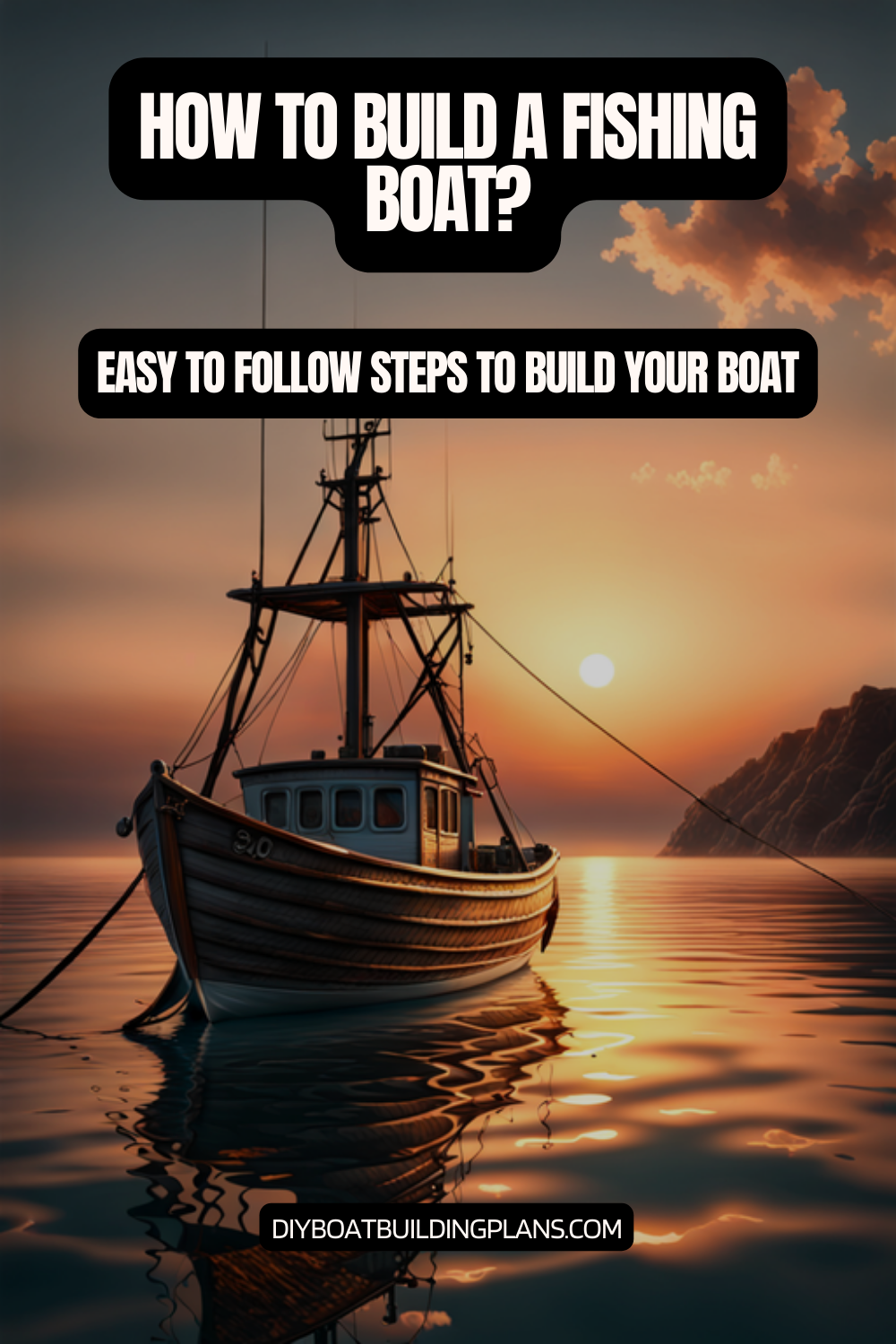Overview of How To Build a Fishing Boat
Key Takeaways
- Determine the purpose and design of your fishing boat before starting construction
- Gather all necessary materials and tools before beginning the build
- Construct the hull and frame of the boat
- Install the deck, seating, and propulsion system
- Equip the boat with fishing gear and accessories, ensuring proper safety features and regulations are in place

Determine the Purpose and Design of Your Fishing Boat
When it comes to building a fishing boat, the first step is to determine the primary purpose of your vessel. Are you looking to create a boat for recreational fishing, commercial fishing, or a combination of both? This decision will greatly influence the design and construction of your boat. If your goal is to use the boat for recreational fishing, you may prioritize features like comfort, storage, and ease of use. On the other hand, if you plan to use the boat for commercial fishing, you’ll need to consider factors such as payload capacity, stability, and durability.
Once you’ve identified the purpose of your fishing boat, you’ll need to consider the size, weight, and intended use of the vessel. A smaller, lightweight boat may be more suitable for solo or small-group fishing trips, while a larger, heavier boat may be better equipped for carrying more gear and accommodating a larger crew. Additionally, the design of the boat should be tailored to the specific fishing activities you plan to engage in, such as inshore, offshore, or river fishing.
After assessing the purpose and intended use of your fishing boat, it’s time to research different boat designs and select the one that best suits your needs and skill level. This may involve studying the characteristics of various hull shapes, propulsion systems, and features to determine the most appropriate option. It’s also a good idea to create a detailed plan or sketch of the boat’s dimensions, shape, and features to guide the construction process.
Gather the Necessary Materials and Tools
Constructing a fishing boat requires a comprehensive list of materials, including wood, fiberglass, epoxy, fasteners, and sealants. Ensure that you have access to all the necessary materials in your local area or through online suppliers. Research the availability and cost of these materials to ensure that you have a clear understanding of the project’s budget.
In addition to the materials, you’ll need to gather the appropriate power tools, hand tools, and safety equipment. This may include items such as saws, sanders, drills, clamps, and personal protective equipment like goggles, gloves, and respirators. Organize these tools in a way that will facilitate the construction process and make it easier to access the items you need.
It’s important to carefully consider the quality and durability of the materials and tools you choose. Investing in high-quality components can help ensure the longevity and performance of your homemade fishing boat. Additionally, familiarize yourself with the proper use and maintenance of the tools to ensure a safe and efficient construction process.
Construct the Hull and Frame
The foundation of your fishing boat is the frame, which provides the structural support for the entire vessel. Begin by carefully measuring and cutting the wood or other materials to the specified dimensions outlined in your detailed plan. Assemble the frame using the appropriate fasteners and techniques, ensuring that it is sturdy and well-aligned.
Once the frame is in place, it’s time to attach the hull material, such as plywood or fiberglass, to create a watertight and durable structure. This process requires precision and attention to detail to ensure a seamless and secure connection between the frame and the hull. Consider the specific characteristics of the hull material, such as its strength, flexibility, and resistance to water, to ensure that it meets the demands of your fishing boat.
During the construction of the hull and frame, it’s crucial to maintain a high level of craftsmanship and attention to detail. Any flaws or inconsistencies in the structure can compromise the boat’s stability, performance, and safety. Take the time to carefully measure, cut, and assemble each component, and be prepared to make adjustments or modifications as needed to achieve the desired result.
Install the Deck and Seating
| Step | Description |
|---|---|
| 1 | Choose the type of boat you want to build |
| 2 | Acquire the necessary materials and tools |
| 3 | Build the frame of the boat |
| 4 | Add the decking and flooring |
| 5 | Install the electrical and plumbing systems |
| 6 | Paint and finish the boat |
| 7 | Launch and test the boat |
The deck of your fishing boat serves multiple purposes, from providing a stable and accessible platform for fishing activities to offering storage and organization for your gear. When designing and constructing the deck, consider factors such as accessibility, storage needs, and the specific fishing activities you plan to engage in.
Incorporate the seating area into the deck design, ensuring that it is comfortable and ergonomic for the intended use of the boat. This may involve incorporating features like adjustable seats, padded cushions, or even built-in storage compartments. Carefully consider the placement and layout of the seating to optimize the boat’s functionality and balance.
In addition to the seating, you may also want to integrate other features into the deck design, such as hatches, storage compartments, or even a live well for keeping your catch fresh. Ensure that these components are seamlessly integrated into the overall design, providing a cohesive and practical layout for your fishing boat.
Add the Propulsion System
The propulsion system is a critical component of your fishing boat, as it determines the vessel’s speed, maneuverability, and overall performance. Carefully consider the appropriate propulsion system for your boat, whether it’s an outboard motor, an inboard engine, or even oars.
Once you’ve selected the propulsion system, focus on properly installing and connecting it to the boat’s electrical and fuel systems. Ensure that the system is securely mounted and aligned, and that all necessary components, such as the fuel tank, wiring, and controls, are properly integrated.
After the installation, it’s essential to thoroughly test the propulsion system to ensure it is functioning correctly and providing the desired speed and maneuverability. Make any necessary adjustments or modifications to optimize the system’s performance and ensure the safety and reliability of your fishing boat.
Equip the Boat with Fishing Gear and Accessories
Outfitting your homemade fishing boat with the appropriate gear and accessories is crucial for enhancing its functionality and meeting your specific fishing needs. Select and install the necessary fishing equipment, such as rod holders, tackle storage, and fish finders, ensuring that they are easily accessible and securely mounted.
Consider adding additional features that will further improve the boat’s capabilities, such as a live well for keeping your catch fresh, bait storage, or a fish cleaning station. These specialized features can make your fishing trips more efficient and enjoyable.
Customizing the boat’s interior and exterior to reflect your personal style and preferences can also be a rewarding aspect of the building process. Incorporate design elements, colors, or graphics that align with your vision and help make the boat truly your own.
Ensure Proper Safety Features and Regulations
Before taking your homemade fishing boat out on the water, it’s essential to familiarize yourself with the local and national regulations regarding the construction and operation of such vessels. Ensure that your boat meets all the necessary safety requirements, such as the installation of life jackets, fire extinguishers, and navigation lights.
Proper weight distribution and buoyancy are also crucial for the boat’s stability and safety. Carefully consider the placement and securement of all components to maintain the vessel’s balance and prevent any potential issues while on the water.
Obtaining the necessary permits or registrations required for operating your handcrafted fishing boat is also an important step. This will not only ensure compliance with local laws but also provide you with the necessary documentation and peace of mind when enjoying your fishing adventures.
Test and Troubleshoot Your Homemade Fishing Boat
Once your fishing boat is fully constructed, it’s time to put it through a thorough testing phase. This involves evaluating the boat’s performance, including its handling, speed, and stability, to ensure that it meets your expectations and operates safely.
During the testing process, be prepared to identify and address any issues or problems that may arise. This may involve making adjustments to the propulsion system, the weight distribution, or other components to improve the boat’s functionality and safety.
Familiarize yourself with the boat’s operation and maintenance requirements before taking it out on the water. This will help you better understand the vessel’s capabilities and limitations, and ensure that you can properly care for and maintain it over time.
Maintain and Care for Your Handcrafted Fishing Vessel
Proper maintenance and care are essential for ensuring the longevity and optimal performance of your homemade fishing boat. Develop a regular maintenance routine that includes inspecting and addressing any wear or damage to the hull, deck, propulsion system, and other components.
Cleaning and storing the boat properly when not in use is also crucial for protecting it from environmental factors, such as UV exposure, moisture, and temperature fluctuations. This may involve covering the boat, storing it in a dry and protected area, or even performing seasonal maintenance tasks.
Continuously monitoring and addressing any issues that may arise is key to keeping your handcrafted fishing boat in top condition. By staying vigilant and proactive with maintenance, you can ensure that your vessel remains safe, reliable, and ready for many fishing adventures to come.
Building a fishing boat from scratch can be a rewarding and challenging project, but with the right approach and attention to detail, you can create a vessel that perfectly suits your needs and provides years of enjoyment on the water. By following the steps outlined in this guide, you’ll be well on your way to constructing a custom fishing boat that will become a cherished part of your outdoor pursuits.
Download over 500 Boat Plans. Click on the link below.
-->Click Here<--

Conclusion – How To Build a Fishing Boat
In conclusion, building your own fishing boat using the stitch and glue method is a rewarding and cost-effective way to create a watercraft that perfectly suits your needs and preferences. Throughout this guide, we’ve covered the essential steps, from choosing a design and making a plan, to cutting and stitching the panels, adding bulkheads and fairing the hull, applying fiberglass, painting, installing hardware, and adding those personalized finishing touches.
Not only does building your own fishing boat provide significant financial savings compared to buying a ready-made vessel, but it also offers the opportunity to learn valuable skills, express your individuality, and experience a deep sense of accomplishment. With the right tools, materials, and safety precautions, you can embark on this DIY adventure and craft a fishing boat that you can be proud of.
So, whether you’re looking to cast your line for fun, food, or profit, the journey of building your fishing boat can lead to years of enjoyment on the water. From choosing the best marine plywood to deciding on the ideal thickness for different parts of the boat, it’s essential to gather the right materials and tools to ensure the success of your project.
FAQs
What materials are needed to build a fishing boat?
The materials needed to build a fishing boat include marine plywood, epoxy resin, fiberglass cloth, marine paint, screws, nails, and other hardware.
What tools are required to build a fishing boat?
The tools required to build a fishing boat include a circular saw, jigsaw, drill, hammer, screwdriver, measuring tape, level, and clamps.
What is the process of building a fishing boat?
The process of building a fishing boat involves designing the boat, cutting and assembling the plywood, applying epoxy resin and fiberglass cloth, sanding and painting the boat, and installing hardware such as seats, oars, and fishing equipment.
How long does it take to build a fishing boat?
The time it takes to build a fishing boat depends on the size and complexity of the boat, as well as the skill level of the builder. It can take anywhere from a few weeks to several months to complete a fishing boat.
What are the benefits of building a fishing boat?
Building a fishing boat allows you to customize the boat to your specific needs and preferences, and can be a rewarding and fulfilling experience. It can also be more cost-effective than buying a pre-built boat.
What are some safety considerations when building a fishing boat?
When building a fishing boat, it is important to wear protective gear such as gloves and safety glasses, and to work in a well-ventilated area. It is also important to follow all instructions and safety guidelines for the tools and materials being used.



